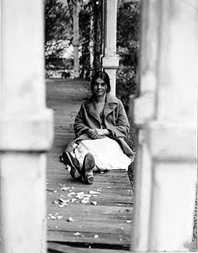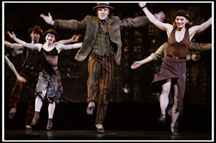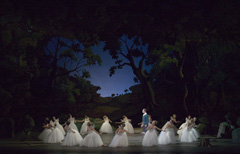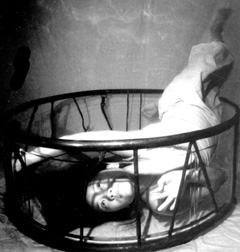Letter from New York
26 January 2004.
Copyright © 2004 by
Mindy Aloff
published 26 January 2004
 Last
Wednesday, at the Museum of Television & Radio—which is celebrating
Balanchine’s centenary birth year with programs that showcase the
spectacular array of his televised works in the museum’s library—it
was stunningly obvious that what made his dancers look different from
any others during his lifetime was the way they phrased the choreography,
and the way the guidelines for phrasing were built into that choreography,
too. They danced as if they were speaking, with strong accents and half
accents, and pauses, and energy rising (that is, with attack) or falling
(that is, with cadences). Their dancing had the texture of witty conversation,
and what they were dancing gave them something substantial to say. Inevitably,
this physical commentary addressed the music. Regardless of how many people
were on stage, the overarching engagement between dance and music in a
Balanchine ballet lent even a solo the intimate give-and-take of a whispered
exchange. The choreography had themes (subjects) and variations (predicates),
and its hair-trigger velocities, continuously modulated like gears being
shifted in a sports car, conveyed the visceral sense that, in every sentence,
the dancing was, from initial cap to period, all verb.
Last
Wednesday, at the Museum of Television & Radio—which is celebrating
Balanchine’s centenary birth year with programs that showcase the
spectacular array of his televised works in the museum’s library—it
was stunningly obvious that what made his dancers look different from
any others during his lifetime was the way they phrased the choreography,
and the way the guidelines for phrasing were built into that choreography,
too. They danced as if they were speaking, with strong accents and half
accents, and pauses, and energy rising (that is, with attack) or falling
(that is, with cadences). Their dancing had the texture of witty conversation,
and what they were dancing gave them something substantial to say. Inevitably,
this physical commentary addressed the music. Regardless of how many people
were on stage, the overarching engagement between dance and music in a
Balanchine ballet lent even a solo the intimate give-and-take of a whispered
exchange. The choreography had themes (subjects) and variations (predicates),
and its hair-trigger velocities, continuously modulated like gears being
shifted in a sports car, conveyed the visceral sense that, in every sentence,
the dancing was, from initial cap to period, all verb.
read
letter
read past Letters from New York
Preview
Yes Dance Is
by
Ann Murphy
Copyright © 2004
by Ann Murphy
published
26 January 2004
Four hundred years ago a bunch of Puritans condemned dance as the work of the devil. Since then, Americans have not only worked dance back into their lives but made the US an international leader in the art. You would think that no one would still need to ask what dance is.
But apparently
they do, because this coming weekend marks the first annual Dance Is festival
at the Julia Morgan Center for the Arts in Berkeley, with each of its
three days defining dance through a particular category—Friday,
dance is movement, Saturday, dance is story, and Sunday, dance is social
change. Twenty-five different companies or performers are on the bill,
and run the gamut from a high school student who began dancing three months
ago on a dare, to veteran dancemakers with dozens of dances to their names.
read article
In
Memoriam
Nina Fichter
by
Paul Parish
Copyright © 2004
by Paul Parish
published
26 January 2004

read article
Acts
of Ardor:
Two Dances of Paul Taylor
By
Dale Brauner
copyright © 2004 by Dale Brauner
published
26 January 2004
 Dance
in America presents “Acts of Ardor: Two Dances by Paul Taylor,”
on Wednesday, January 28 as part of Great Performances on PBS (check local
listings) as its first performance presentation. This is a return byTaylor
to Dance in America, which has broadcast some of his most celebrated works
in Aureole, Esplanade, 3 Epitaphs, Arden Court, The Rite of Spring
(The Rehearsal), Roses, Last Look, Speaking in Tongues, Company B, Funny
Papers and A field of Grass.
Dance
in America presents “Acts of Ardor: Two Dances by Paul Taylor,”
on Wednesday, January 28 as part of Great Performances on PBS (check local
listings) as its first performance presentation. This is a return byTaylor
to Dance in America, which has broadcast some of his most celebrated works
in Aureole, Esplanade, 3 Epitaphs, Arden Court, The Rite of Spring
(The Rehearsal), Roses, Last Look, Speaking in Tongues, Company B, Funny
Papers and A field of Grass.
read review
Replated from last week's midweek edition:
Royal Danish Ballet in D.C.
La Sylphide Restored
La
Sylphide/Etudes
The Royal Danish Ballet
Opera House
Kennedy Center for the Performing Arts
Washington, DC
Saturday and Sunday, January 17-18, 2004
by Alexandra Tomalonis
copyright © 2004 by Alexandra Tomalonis
published
21 January 2004
 When
the curtain rose Saturday afternoon on the Royal Danish Ballet’s
new production of La Sylphide it rose on a miracle. After four
days of a Napoli that, one tried to tell oneself, might be the
best that could be expected after the many changes the company has undergone
in the past decade, the minute Gudrun Bojesen extended her long, beautiful
foot and began to dance, time stopped. What we saw last weekend was, with
allowances for changes in cast and designs, what we saw 11-and-a-half
years ago when the company last danced La Sylphide at the Kennedy
Center. The musicality was there, the poetry was there, the drama, the
pacing, the beautiful soft, clear, modest dancing.
When
the curtain rose Saturday afternoon on the Royal Danish Ballet’s
new production of La Sylphide it rose on a miracle. After four
days of a Napoli that, one tried to tell oneself, might be the
best that could be expected after the many changes the company has undergone
in the past decade, the minute Gudrun Bojesen extended her long, beautiful
foot and began to dance, time stopped. What we saw last weekend was, with
allowances for changes in cast and designs, what we saw 11-and-a-half
years ago when the company last danced La Sylphide at the Kennedy
Center. The musicality was there, the poetry was there, the drama, the
pacing, the beautiful soft, clear, modest dancing.
read review
Commentary
Bournonville's Next Steps
by
Alexandra Tomalonis
copyright © 2004 by Alexandra Tomalonis
published
21 January 2004
In June of
2005, the Royal Danish Ballet will celebrate Bournonville’s 200th
birthday with a third Festival, at which it will present the surviving
ballets. It will be a festive time, but also a sober one. This may be
the last chance to make the case for Bournonville. There are no credible
opportunities for another Festival for years to come. Will the Danish
audience, and the Danish dancers, want to keep him around for another
century?
read article
Other reviews of the RDB:
Bringing Back the Banned
The
Bright Stream
Bolshoi Ballet
Palais Garnier
Paris, France
January 2004
By
Alexander Meinertz
Copyright
© 2003 Alexander Meinertz
published 26 January 2004
The new
director of the Bolshoi Ballet, Alexei Ratmansky, has performed the unlikely
feat of bringing successfully back to life a Shostakovich ballet banned
by Stalin and denigrated by no less a figure than Agrippina Vaganova.
The Bright Stream was given its European premiere in Paris last
week in connection with the ensemble's season at the Palais Garnier.
read review
Double Trouble
Double Feature
New York City Ballet
New York State Theater
New York, NY
January 23, 2004
by
Mary Cargill
copyright
2004 by Mary Cargill
published 26 January 2004
 In
1999 Susan Stroman, currently the toast of Broadway, choreographed a minor
bauble for the New York City Ballet called “Blossom Got Kissed”.
It was an inconsequentially charming piece about a ballet dancer who learns
to jive and finds romance, clearly told and enjoyable. As an homage to
Balanchine, Stroman was asked to choreograph a full-length work, which
might as well have been called “Blossom Got Mugged.”
In
1999 Susan Stroman, currently the toast of Broadway, choreographed a minor
bauble for the New York City Ballet called “Blossom Got Kissed”.
It was an inconsequentially charming piece about a ballet dancer who learns
to jive and finds romance, clearly told and enjoyable. As an homage to
Balanchine, Stroman was asked to choreograph a full-length work, which
might as well have been called “Blossom Got Mugged.”
read review
An Evening's Debuts
Tschaikovsky Piano Concerto No. 2/Harlequinade
New York City Ballet
New York State Theater
New York, NY
January 20, 2004
by
Mary Cargill
copyright 2004 by Mary Cargill
published 24 January 2004
Jennie Somogyi made her eagerly awaited debut as the lead ballerina in Tschaikovsky Piano Concerto No. 2; she has previously danced gloriously in the second lead. This ballet, so full of the spirit of Petipa, needs a phenomenally accomplished dancer, which of course Somogyi is, as well as an instinctive ballerina, who can make the steps sing her own song. Somogyi does have the rare ability to speak with her body, without imposing a false drama, and it was an extraordinary debut.
The opening
cadenza, where the ballerina (who might as well be called Aurora) dances
a fast and difficult solo, recalls the beautiful princess at her birthday
party, and Somogyi did have the youthful grandeur and grace notes (if
not always impeccably secure turns) to bring the role alive with all its
youthful joy.
read review
The Washington Ballet Celebrates Balanchine
The
Four Temperaments, Sonatine, A Midsummer Night’s Dream
The Washington Ballet
Eisenhower Theater
John F. Kennedy Center for the Performing Arts
January 22-25, 2004
(January 22, 2004)
By
Alexandra Tomalonis
Copyright 2004 by Alexandra Tomalonis
published 26 January 2004
The Washington
Ballet has performed Balanchine works since it was born back in 1976;
often in its early days, there was a Balanchine ballet on every program.
So this all-Balanchine evening, programmed by Artistic Director Septime
Webre to honor the great choreographer on his 100th birthday, is very
much a part of the company’s tradition, not a one-time gesture.
And the company did the ballets proud..
read review
Good Intentions
The
Grim Arithmetic of Water
Jo Kreiter/Flyaway Productions
Cowell Theater
January 23
by
Rita Felciano
Copyright ©2004 by Rita Felciano
published
26 January 2004
 Jo
Kreiter is fixated on steel. The fascination with metal has lead her to
dance on scaffolds, fire escapes, industrial cranes and a variety of contraptions
she had built for herself and her mostly female Flyaway Productions ensemble.
The contrast between the fluidity of the human body and the hardness of
the inflexible material creates a tension that may account for part of
Kreiter’s ongoing partnering with metal. But from a practical point
of view, it allows her to defy gravity—or at least create the illusion—with
airborne choreography that often embodies a kind of yearning for a world
that is more just than the one we live in.
Jo
Kreiter is fixated on steel. The fascination with metal has lead her to
dance on scaffolds, fire escapes, industrial cranes and a variety of contraptions
she had built for herself and her mostly female Flyaway Productions ensemble.
The contrast between the fluidity of the human body and the hardness of
the inflexible material creates a tension that may account for part of
Kreiter’s ongoing partnering with metal. But from a practical point
of view, it allows her to defy gravity—or at least create the illusion—with
airborne choreography that often embodies a kind of yearning for a world
that is more just than the one we live in.
read review
A Vivid, Musical Talent
James
Sewell Ballet
Joyce Theater
New York, NY
January 20, 2004
by
Susan Reiter
copyright
© 2004 by Susan Reiter
published
26 January 2004
 The
lasting impression I carried away from my initial look at James Sewell's
choreography—his troupe's first New York appearance in 2001—was
that it is refreshingly unaffected and musically astute. Having missed
the company's one-performance stop in Brooklyn last spring, the James
Sewell Ballet's first week-long local run was a welcome chance to further
investigate what he has been up to since relocating to Minneapolis in
1993.
The
lasting impression I carried away from my initial look at James Sewell's
choreography—his troupe's first New York appearance in 2001—was
that it is refreshingly unaffected and musically astute. Having missed
the company's one-performance stop in Brooklyn last spring, the James
Sewell Ballet's first week-long local run was a welcome chance to further
investigate what he has been up to since relocating to Minneapolis in
1993.
Sewell was
a prominent member of Eliot Feld's company during the 1980s, particularly
at the time Feld frequently turned to Steve Reich scores and began creating
works that were more gymnastic and impudently playful. Sewell, an elfin,
effervescent dancer with a natural and communicative stage presence who
had studied at the School of American Ballet, was often featured in Feld's
increasingly quirky romps.
read review
Where's the Soul?
Black
Expressions
Jan. 23, 2004, Lincoln Theatre, Washington, DC
Mason/Rhynes Productions, Inc. and Lincoln Theatre
Choreography by: Jennifer Archibald, Christal Brown, Shani Collins, Sandra
Holloway, Gesel Mason, Boris Willis
by Lisa Traiger
copyright © 2004 by Lisa Traiger
published
26 January 2004
 I
had a values clash Friday night. As I sat there in row Z of the Lincoln
Theatre waiting for the programs (which didn't arrive until midway into
the evening's second piece), waiting the show to begin (15 minutes late
with more latecomers filtering in well after that), looking around at
the gathering crowd (an insider's audience of friends and friends-of-friends),
I silently congratulated the producers of this venture for drawing a youthful
and well-heeled crowd downtown to a theater not known for its dance offerings
on a frigid January night.
I
had a values clash Friday night. As I sat there in row Z of the Lincoln
Theatre waiting for the programs (which didn't arrive until midway into
the evening's second piece), waiting the show to begin (15 minutes late
with more latecomers filtering in well after that), looking around at
the gathering crowd (an insider's audience of friends and friends-of-friends),
I silently congratulated the producers of this venture for drawing a youthful
and well-heeled crowd downtown to a theater not known for its dance offerings
on a frigid January night.
read review
|
|
|
|